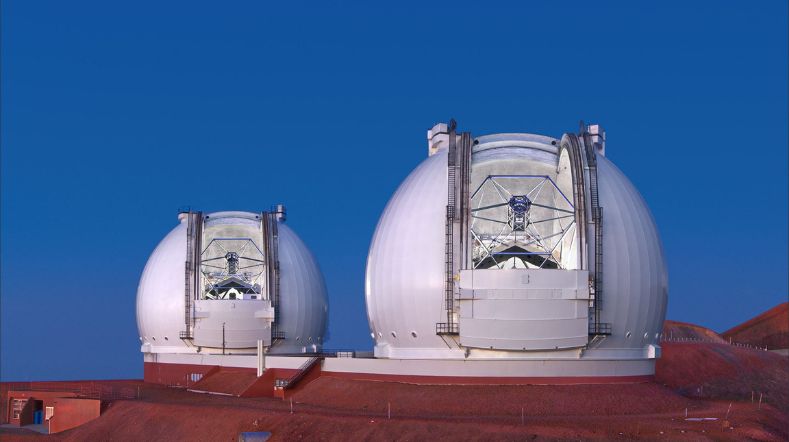TNO is awarded conceptual design of the Gemini North Telescope’s Adaptive Optics Bench
The Gemini North Observatory is one of the largest and most advanced optical and infrared telescopes in the world. It is located on Mauna Kea in Hawaii, one of the world’s premier astronomy locations. The Gemini North telescope has a twin telescope (Gemini South in Chile) leading to the name ’Gemini’ (twins). Both telescopes have of an 8.1-meter primary-mirror. The twin Gemini telescopes provide almost complete coverage of both the northern and southern skies. The telescope saw first light in 1999 and went into science operations in the year 2000.
Phases of the Project
This award is for the Conceptual Design phase of the complex Adaptive Optics (AO) system. A limited number (2-3) conceptual design awards were granted by AURA. Only those teams which were awarded these conceptual design contracts will be qualified to compete for the contract to complete the final design, realization and installation of the system in Hawaii. This initial phase will last approximately 1 year, with the final design and realization phase to last an additional 3-4 years.
The Gemini North Adaptive Options Bench

Adaptive Optics systems allow ground-based telescopes to look into space with corrected vision which rivals space-based telescopes like Hubble. The Gemini telescopes utilize adaptive optics technology to compensate for the blurring effects of the Earth's atmosphere:
’Gemini is a world-leader in wide-field adaptive optics assisted infrared imaging, and has recently commissioned the Gemini Planet Imager, an instrument that allows researchers to directly image and analyze exoplanets that are a millionth as bright as the host star around which they orbit. Gemini continues to support research in almost all areas of modern astronomy, including the Solar System, exoplanets, star formation and evolution, the structure and dynamics of galaxies, supermassive black holes, distant quasars, and the structure of the Universe on the largest scales.’ Source: Wikipedia
The observatory now seeks to upgrade the Gemini North Adaptive Optics (GNAO) Bench, to a fully-automated and remotely-operated system. The GNAO Bench will process the light sources coming in from the telescope’s primary mirror to ’clean up’ the distortions caused by the Earth’s atmosphere to the image (wavefront) which is then sent on to the telescope’s science instruments. The incoming light includes the science objects under study (stars, exo-planets, galaxies, black-holes, etc.), as well light from natural and artificial guide-stars which are used to measure and allow correction of atmospheric distortions.
Components in the complex Optical Bench system include a calibration unit, tip-tilt mirror mechanism, a deformable mirror, wavefront sensors for natural and artificial guide-stars, multiple focusing units, pickoff mirrors, beam-splitters, atmospheric dispersion corrector, asterism selector, reimaging optics, collimators, temperature-compensated backing structure, cover and shutters. TNO was seen as a well-qualified developer, having designed and built all of these types of components in the past, as well as similar optical benches in an array of projects in the areas of astronomy, Earth-observation satellites and laser communications systems.
The Team
TNO has teamed with academic and industry experts to ensure success of the project. Our industry partner is Demcon-FSO, who already works with TNO on laser communications systems and laser projection systems for astronomy, as well as upcoming research on deformable mirrors. TNO has also teamed with top AO Astronomy experts including Dr. Olivier Lai, Observatoire de la Côte d’Azur (CNRS - Laboratoire Lagrange) and Dr. Remko Stuik, NOVA (The Netherlands Research School for Astronomy).
TNO’s Contributions to Astronomy
TNO is excited to take on this project to extend its current roadmap in scientific instrumentation for astronomy. TNO is already a world class leader in ultra-precision structures for astronomy mirrors (like the ELT Primary Mirror Support – with VDL), and Artificial Guide-star Laser Projection Systems (such as for VLT and ELT – with Demcon). Our latest and growing technology development for Astronomy is in Deformable Mirrors for adaptive optics systems (such as for the European Solar Telescope and the UH88 Telescope). This GNAO Bench project gives us the opportunity to work with partners and add TNO’s top opto-mechatronics expertise, to expand our Astronomy roadmap into full Adaptive Optics systems. Read more tno.nl/astronomy
Get inspired
Laser projection systems


Deformable mirrors


Ground-based astronomy


Jan Nijenhuis appointed Knight in the Order of the Lion of the Netherlands


TNO to Apply Latest Adaptive Mirror Technology


